A) marginal product is negative.
B) average product is at its maximum value.
C) marginal product is at its maximum value.
D) the marginal product curve is upward sloping.
E) average product is at its minimum value.
Correct Answer

verified
B
Correct Answer
verified
Multiple Choice
When Coffee 'n' Cream in Victoria,British Columbia hires two students,64 customers can be served in one hour.Suppose the manager of the restaurant observes that after hiring the third student,80 customers are being served in one hour.The marginal product of the third student is ________ customers per hour.
A) 4
B) 16
C) 8
D) 26.67
E) 32
Correct Answer

verified
Correct Answer
verified
Multiple Choice
Which of the following factors are fixed in the long run?
A) labour
B) capital
C) land
D) entrepreneurship
E) No factors of production are fixed in the long run.
Correct Answer

verified
Correct Answer
verified
Multiple Choice
Use the figure below to answer the following questions. 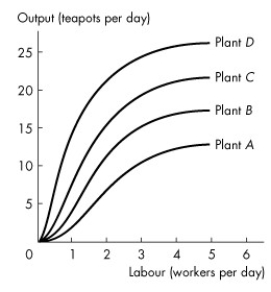 Figure 10.4.1
-Refer to Figure 10.4.1,which illustrates the total product curves for four different plant sizes.One of the fundamental technological facts reflected in the shape of each of the total product curves is the
Figure 10.4.1
-Refer to Figure 10.4.1,which illustrates the total product curves for four different plant sizes.One of the fundamental technological facts reflected in the shape of each of the total product curves is the
A) price of the inputs.
B) price of the output.
C) law of diminishing marginal returns.
D) law of economies of scale.
E) fact that capital and labour cannot be substituted for each other.
Correct Answer

verified
Correct Answer
verified
Multiple Choice
Refer to the table below to answer the following questions.
Table 10.2.1
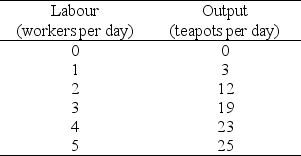 -Refer to Table 10.2.1 which gives Tania's Teapots' total product schedule.Average product of labour reaches its maximum for the ________ worker.
-Refer to Table 10.2.1 which gives Tania's Teapots' total product schedule.Average product of labour reaches its maximum for the ________ worker.
A) first
B) second
C) third
D) fourth
E) fifth
Correct Answer

verified
Correct Answer
verified
Multiple Choice
The marginal cost curve slopes upward due to
A) diminishing marginal utility.
B) diminishing marginal returns.
C) technological inefficiency.
D) economic inefficiency.
E) spreading fixed costs over a larger output.
Correct Answer

verified
Correct Answer
verified
Multiple Choice
Diseconomies of scale are present when
A) the LRAC curve slopes downward.
B) average total cost falls as input increases.
C) average total cost rises as output increases.
D) the LRAC curve is horizontal.
E) total fixed cost increases.
Correct Answer

verified
C
Correct Answer
verified
Multiple Choice
Refer to the table below to answer the following questions.
Table 10.2.1
 -Refer to Table 10.2.1 which gives Tania's Teapots' total product schedule.Marginal product of labour reaches its maximum when the number of workers increases from
-Refer to Table 10.2.1 which gives Tania's Teapots' total product schedule.Marginal product of labour reaches its maximum when the number of workers increases from
A) 0 to 1.
B) 1 to 2.
C) 2 to 3.
D) 3 to 4.
E) 4 to 5
Correct Answer

verified
Correct Answer
verified
Multiple Choice
Use the table below to answer the following questions.
Table 10.4.1
Swanky's output levels 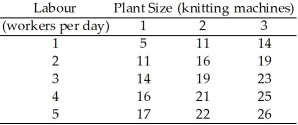 -Refer to Table 10.4.1,which represents Swanky's production possibilities as the firm varies the quantities of knitting machines and workers per day.If Swanky increases the number of knitting machines from 1 to 2 and increases the number of workers employed from 1 to 2,the factory experiences
-Refer to Table 10.4.1,which represents Swanky's production possibilities as the firm varies the quantities of knitting machines and workers per day.If Swanky increases the number of knitting machines from 1 to 2 and increases the number of workers employed from 1 to 2,the factory experiences
A) economies of scale.
B) constant returns to scale.
C) diseconomies of scale.
D) constant marginal product.
E) minimum efficient scale.
Correct Answer

verified
Correct Answer
verified
Multiple Choice
In the long run,a firm has no factors of production that are
A) variable.
B) marginal.
C) significant.
D) taxable.
E) fixed.
Correct Answer

verified
Correct Answer
verified
Multiple Choice
Refer to the table below to answer the following questions.
Table 10.2.1
 -Refer to Table 10.2.1 which gives Tania's Teapots' total product schedule.The marginal product when Tania's increases the number of workers from 3 to 4 per day is
-Refer to Table 10.2.1 which gives Tania's Teapots' total product schedule.The marginal product when Tania's increases the number of workers from 3 to 4 per day is
A) 6 teapots.
B) 2 teapots.
C) 9 teapots.
D) 7 teapots.
E) 4 teapots.
Correct Answer

verified
Correct Answer
verified
Multiple Choice
The marginal cost curve slopes downward at low outputs because of ________.The marginal cost curve eventually slopes upward because of ________.
A) greater specialization and division of labour;the law of diminishing returns
B) the law of diminishing returns;increasing average fixed cost
C) falling average fixed cost;the law of diminishing returns
D) the law of diminishing returns;greater specialization and division of labour
E) greater specialization and division of labour;rising average fixed cost
Correct Answer

verified
Correct Answer
verified
Multiple Choice
If energy (E) is the only input used to produce output (Q) ,what is the formula for average product of energy?
A) ΔQ/ΔE
B) Q/E
C) ΔE/ΔQ
D) E/Q
E) Q ∗ E
Correct Answer

verified
Correct Answer
verified
Multiple Choice
Plant refers to those factors of production
A) that are too expensive for the firm to purchase.
B) that must be held in storage for at least one year.
C) that are fixed in the short run.
D) that have a decreasing marginal product as more of the factor is used.
E) which can be purchased only in fixed quantity lots.
Correct Answer

verified
Correct Answer
verified
Multiple Choice
Use the table below to answer the following questions.
Table 10.4.1
Swanky's output levels  -Refer to Table 10.4.1,which represents Swanky's production possibilities as the firm varies the quantities of knitting machines and workers per day.If Swanky increases the number of knitting machines from 2 to 3 and increases the number of workers employed from 2 to 3,the factory experiences
-Refer to Table 10.4.1,which represents Swanky's production possibilities as the firm varies the quantities of knitting machines and workers per day.If Swanky increases the number of knitting machines from 2 to 3 and increases the number of workers employed from 2 to 3,the factory experiences
A) economies of scale.
B) constant returns to scale.
C) diseconomies of scale.
D) constant marginal product.
E) minimum efficient scale.
Correct Answer

verified
Correct Answer
verified
Multiple Choice
Use the table below to answer the following questions.
Table 10.3.1 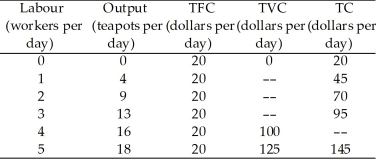 -Refer to Table 10.3.1,which gives Tania's Teapots' total cost schedule.The average total cost of producing 16 teapots per day is
-Refer to Table 10.3.1,which gives Tania's Teapots' total cost schedule.The average total cost of producing 16 teapots per day is
A) $2.
B) $5.
C) $3.33.
D) $7.50.
E) $5.51.
Correct Answer

verified
Correct Answer
verified
Multiple Choice
If the total product of four workers is 156 units,the average product of each worker is
A) 39 units.
B) 19.5 units.
C) 78 units.
D) 152 units.
E) 624 units.
Correct Answer

verified
Correct Answer
verified
Multiple Choice
If energy (E) is the only input used to produce output (Q) ,what is the formula for marginal product of energy?
A) Q ∗ E
B) Q/E
C) ΔQ/ΔE
D) ΔE/ΔQ
E) E/Q
Correct Answer

verified
Correct Answer
verified
Multiple Choice
Marginal cost equals
A) TC/Q.
B) Q/TVC.
C) (TC - TVC) /Q.
D) TC/ΔQ.
E) ΔTC/ΔQ.
Correct Answer

verified
Correct Answer
verified
Multiple Choice
Use the figure below to answer the following questions. 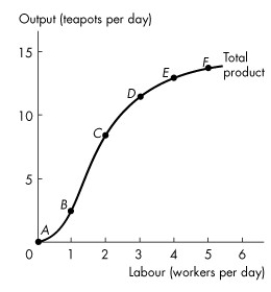 Figure 10.2.1
-Refer to Figure 10.2.1 which illustrates Tania's Teapots' total product curve.Marginal product of labour reaches its maximum when the number of workers increases from
Figure 10.2.1
-Refer to Figure 10.2.1 which illustrates Tania's Teapots' total product curve.Marginal product of labour reaches its maximum when the number of workers increases from
A) zero to 1.
B) 1 to 2.
C) 2 to 3.
D) 3 to 4.
E) 4 to 5.
Correct Answer

verified
B
Correct Answer
verified
Showing 1 - 20 of 145
Related Exams